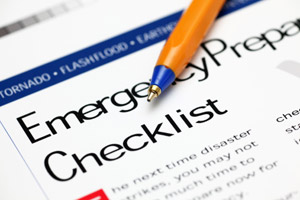No one wants or expects an emergency situation to occur in their home. And unfortunately, no one can prevent an accident, disaster or other emergency situations. You can help protect and prepare your family by using this helpful emergency safety checklist.
- Alarm systems are an important part of protecting your home. Without a working alarm system, you are putting your family and property at risk for home intrusion, fire, or carbon monoxide poisoning. It’s important to keep fresh batteries in all of your alarms. Also, perform a quick monthly check on all of your alarms to ensure they will function properly in the event of an emergency.
- Talk to your family and develop a fire escape plan. Map out and draw a plan that includes at least two exits from each room of your house. Make sure everyone in your family knows where the designated exits are and practice, practice, practice. Decide on a family meeting place for everyone to go to after escaping from a fire. An ideal location is one that is away from danger such as a trusted neighbor’s house across the street.
- Keep extra candles, firewood, flashlights, batteries and matches or a lighter on hand in case of a power outage. Store these items in a place that is easy for you to find in the dark.
- Create an emergency survival kit for each member of the family that has enough personal supplies to live on for at least three days outside of your home. Fill an easy-to-carry, closeable bag or backpack with non-perishable foods (granola bars, tuna, etc.), water, a flashlight, tissues, hand wipes, change of clothes, knife and a blanket. Even checking to see if you need a Philips OnSite defibrillator before traveling may also be a good idea, especially if someone in your inner circle has heart difficulties, as you might not have access to one otherwise. Set aside an afternoon to create these kits with your family. During that time, explain the purpose of the kits and when you would use them. Store your family’s kits in an area of your home that is easily accessible to everyone including children. First aid kits also need to be included in these packs so bear this in mind too. Visit websites like MFASCO to learn about which products you need to have in the first aid kits to ensure you’re fully prepared for any emergency.
- The adults of the household should keep a file of important documents in their emergency survival kits. Include personal, financial and insurance information. Also include copies of birth certificates and social security cards for everyone in your home. Remember to keep some cash in your kit. It may take a few days to get things sorted out and you don’t want to be stranded without funds for food or a place to stay.
- If you have a car, prepare a small emergency bag that includes gloves, a change of clothes, flashlight, shovel, first aid kit, water, money and non-perishable food. If you have a cell phone, you may want to invest in a travel charger to use in your car. A phone is useless if it is dead and you never know when you will need to contact someone for help. You should also ensure your car is always insured. Once your policy runs out, be sure to renew it straight away as you don’t want to leave in a rush and realize your car is uninsured. Find out how to get car insurance here.
By following this safety list, you can breathe a little easier and know that in an emergency you and your family will be prepared. Start crossing items off of your emergency safety checklist today, it may make a difference tomorrow. Remember to be prepared for plumbing emergencies too. If you’re in the Toronto area, research local plumbers for example absolutedp.com and keep their details handy in case of emergency.



